Itinerary
Set on seven hills on the banks of the River Tagus, Lisbon has been the capital of Portugal since the 13th century. It is a city famous for its majestic architecture, old wooden trams, Moorish features and more than twenty centuries of history. Following disastrous earthquakes in the 18th century, Lisbon was rebuilt by the Marques de Pombal who created an elegant city with wide boulevards and a great riverfront and square, Praça do Comércio. Today there are distinct modern and ancient sections, combining great shopping with culture and sightseeing in the Old Town, built on the city’s terraced hillsides. The distance between the ship and your tour vehicle may vary. This distance is not included in the excursion grades.
Believed to be the oldest town on the Iberian Peninsula, the Andalusian port of Cádiz enjoys a stunning location at the edge of a six-mile promontory. The town itself, with 3,000 years of history, is characterised by pretty white houses with balconies often adorned with colourful flowers. As you wander around be sure to take a stroll through the sizeable Plaza de Espãna, with its large monument dedicated to the first Spanish constitution, which was signed here in 1812. Cádiz has two pleasant seafront promenades which boast fine views of the Atlantic Ocean, and has a lovely park, the Parque Genoves, located close to the sea with an open-air theatre and attractive palm garden. Also notable is the neo-Classical cathedral, capped by a golden dome.
Tangier can trace its origins back to the Phoenicians and ancient Greeks. It was named after Tinge, the mother of Hercules’ son, and its beginnings are embedded in mythology. It was subsequently a Roman province, and after Vandal and Byzantine influences, was occupied by the Arabs with Spain, Portugal, France and England also playing a part in the city’s history. With such a diverse past it is perhaps not surprising that Tangier is such an individual city. Overlooking the Straits of Gibraltar, the city lies on a bay between two promontories. With its old Kasbah, panoramic views, elegant buildings, squares and places of interest, there is much to discover in both the new and old parts of the city.
As you sail into Malaga you will notice what an idyllic setting the city enjoys on the famous Costa del Sol. To the east of this provincial capital, the coast along the region of La Axarqua is scattered with villages, farmland and sleepy fishing hamlets – the epitome of traditional rural Spain. To the west stretches a continuous city where the razzmatazz and bustle creates a colourful contrast that is easily recognisable as the Costa del Sol. Surrounding the region, the Penibéetica Mountains provide an attractive backdrop overlooking the lower terraced slopes which yield olives and almonds. This spectacular mountain chain shelters the province from cold northerly winds, giving it a reputation as a therapeutic and exotic place in which to escape from cold northern climes. Malaga is also the gateway to many of Andalusia’s enchanting historic villages, towns and cities.
Tagged on to the end of Iberia, the intriguing British outpost of Gibraltar is dominated by a sandy peninsula and the stunning 1,400-feet-high limestone Rock. Although small, Gibraltar has always been seen as having great strategic importance on account of its advantageous position where the Atlantic meets the Mediterranean, just 12 miles from the coast of Africa. Ever popular with British holidaymakers, Gibraltar is very much a home from home, boasting excellent duty-free shopping in many familiar British high street shops. Please note: Gibraltar’s small size and narrow winding roads mean that excursions are operated by 22-seater mini-buses, accompanied by a driver/guide. Local health and safety regulations prohibit the carriage of walking aids and collapsible wheelchairs on these vehicles. If you do wish to bring a mobility aid, we can arrange the Rock Tour by taxi, which has extra space. If this suits your requirements, please advise the Tours and Travel office when you join the ship, as numbers are limited.
Valencia, Spain’s third-largest municipality, is a proud city with a thriving nightlife and restaurant scene, quality museums, and spectacular contemporary architecture, juxtaposed with a thoroughly charming historic quarter, making it a popular destination year in year out. During the Civil War, it was the last seat of the Republican Loyalist government (1935–36), holding out against Franco’s National forces until the country fell to 40 years of dictatorship. Today it represents the essence of contemporary Spain—daring design and architecture along with experimental cuisine—but remains deeply conservative and proud of its traditions. Though it faces the Mediterranean, Valencia’s history and geography have been defined most significantly by the River Turia and the fertile huerta that surrounds it.The city has been fiercely contested ever since it was founded by the Greeks. El Cid captured Valencia from the Moors in 1094 and won his strangest victory here in 1099: he died in the battle, but his corpse was strapped into his saddle and so frightened the besieging Moors that it caused their complete defeat. In 1102 his widow, Jimena, was forced to return the city to Moorish rule; Jaume I finally drove them out in 1238. Modern Valencia was best known for its frequent disastrous floods until the River Turia was diverted to the south in the late 1950s. Since then the city has been on a steady course of urban beautification. The lovely bridges that once spanned the Turia look equally graceful spanning a wandering municipal park, and the spectacularly futuristic Ciutat de les Arts i les Ciències (City of Arts and Sciences), most of it designed by Valencia-born architect Santiago Calatrava, has at last created an exciting architectural link between this river town and the Mediterranean. If you’re in Valencia, an excursion to Albufera Nature Park is a worthwhile day trip.
If you look north of the cathedral (La Seu, or the seat of the bishopric, to Mallorcans) on a map of the city of Palma, you can see around the Plaça Santa Eulàlia a jumble of tiny streets that made up the earliest settlement. Farther out, a ring of wide boulevards traces the fortifications built by the Moors to defend the larger city that emerged by the 12th century. The zigzags mark the bastions that jutted out at regular intervals. By the end of the 19th century, most of the walls had been demolished; the only place where you can still see the massive defenses is at Ses Voltes, along the seafront west of the cathedral.A torrent (streambed) used to run through the middle of the old city, dry for most of the year but often a raging flood in the rainy season. In the 17th century it was diverted to the east, along the moat that ran outside the city walls. Two of Palma’s main arteries, La Rambla and the Passeig d’es Born, now follow the stream’s natural course. The traditional evening paseo (promenade) takes place on the Born.If you come to Palma by car, park in the garage beneath the Parc de la Mar (the ramp is just off the highway from the airport, as you reach the cathedral) and stroll along the park. Beside it run the huge bastions guarding the Almudaina Palace; the cathedral, golden and massive, rises beyond. Where you exit the garage, there’s a ceramic mural by the late Catalan artist and Mallorca resident Joan Miró, facing the cathedral across the pool that runs the length of the park.If you begin early enough, a walk along the ramparts at Ses Voltes from the mirador beside the cathedral is spectacular. The first rays of the sun turn the upper pinnacles of La Seu bright gold and then begin to work their way down the sandstone walls. From the Parc de la Mar, follow Avinguda Antoni Maura past the steps to the palace. Just below the Plaça de la Reina, where the Passeig d’es Born begins, turn left on Carrer de la Boteria into the Plaça de la Llotja (if the Llotja itself is open, don’t miss a chance to visit—it’s the Mediterranean’s finest Gothic-style civic building). From there stroll through the Plaça Drassana to the Museu d’Es Baluard, at the end of Carrer Sant Pere. Retrace your steps to Avinguda Antoni Maura. Walk up the Passeig d’es Born to Plaça Joan Carles I, then right on Avenida de La Unió.
If you look north of the cathedral (La Seu, or the seat of the bishopric, to Mallorcans) on a map of the city of Palma, you can see around the Plaça Santa Eulàlia a jumble of tiny streets that made up the earliest settlement. Farther out, a ring of wide boulevards traces the fortifications built by the Moors to defend the larger city that emerged by the 12th century. The zigzags mark the bastions that jutted out at regular intervals. By the end of the 19th century, most of the walls had been demolished; the only place where you can still see the massive defenses is at Ses Voltes, along the seafront west of the cathedral.A torrent (streambed) used to run through the middle of the old city, dry for most of the year but often a raging flood in the rainy season. In the 17th century it was diverted to the east, along the moat that ran outside the city walls. Two of Palma’s main arteries, La Rambla and the Passeig d’es Born, now follow the stream’s natural course. The traditional evening paseo (promenade) takes place on the Born.If you come to Palma by car, park in the garage beneath the Parc de la Mar (the ramp is just off the highway from the airport, as you reach the cathedral) and stroll along the park. Beside it run the huge bastions guarding the Almudaina Palace; the cathedral, golden and massive, rises beyond. Where you exit the garage, there’s a ceramic mural by the late Catalan artist and Mallorca resident Joan Miró, facing the cathedral across the pool that runs the length of the park.If you begin early enough, a walk along the ramparts at Ses Voltes from the mirador beside the cathedral is spectacular. The first rays of the sun turn the upper pinnacles of La Seu bright gold and then begin to work their way down the sandstone walls. From the Parc de la Mar, follow Avinguda Antoni Maura past the steps to the palace. Just below the Plaça de la Reina, where the Passeig d’es Born begins, turn left on Carrer de la Boteria into the Plaça de la Llotja (if the Llotja itself is open, don’t miss a chance to visit—it’s the Mediterranean’s finest Gothic-style civic building). From there stroll through the Plaça Drassana to the Museu d’Es Baluard, at the end of Carrer Sant Pere. Retrace your steps to Avinguda Antoni Maura. Walk up the Passeig d’es Born to Plaça Joan Carles I, then right on Avenida de La Unió.

Our two owner suites follow the tradition in the maritime world of always having their own cabins ready for the ship owners. We have reserved these living areas for those of our guests who appreciate special comfort and cosiness even on board a tall ship. Both light-flooded suites are located on the lidodeck and with their large panoramic windows offer a unique view of the sea even from a four-poster bed. The spacious ambience includes selected individual pieces of furniture, four large cupboards, the fireplace – and last but not least the large bathroom with bathtub and separate shower, marble washstand including the legendary golden fittings.

With their rosewood furniture, stucco elements on the walls and a decorative marble fireplace, the Junior Suites are the epitome of Hanseatic solidity. The simple elegance corresponds in gentle tension with the maritime atmosphere in front of the panorama windows, which offer a view of the vastness of the sea. A separate sitting area and a walk-in closet round off the comfortable ambience. Bathtub, marble washbasin and golden fittings are of course also standard in this category. The junior suites are located on the promenade deck, so that the restaurant, boutique and reception can easily be reached.
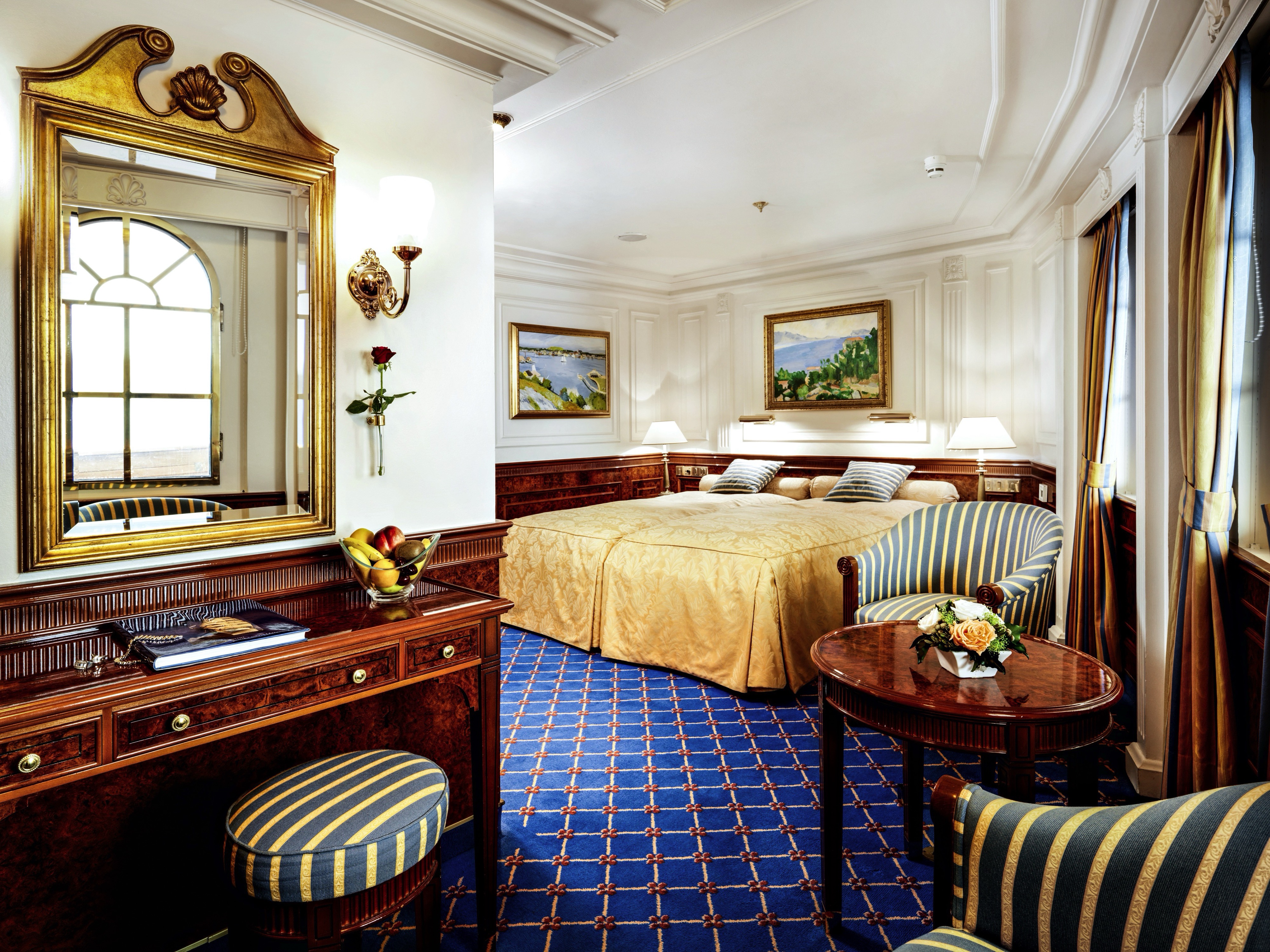
This De-Luxe outside cabin combines the comfort and solidity that characterizes the suites with a special maritime cosiness. Thanks to its location in the front area of the promenade deck, the floor plan follows the elegant line of the SEA CLOUD II and thus additionally conveys the feeling of security on a luxury private yacht. The panorama windows offer a wonderful view of the sea.

The three large porthole windows give our De-Luxe Category D outside cabins a special maritime flair. Together with their luxurious yacht ambience, these cabins underline the feeling of being part of an extraordinary journey on an extraordinary ship. Stylish individual pieces of furniture and a beautiful seating area make the spacious room cosy. The six De-Luxe outside cabins are located amidships on the same deck where the massage and cosmetic treatments, the fitness room, the bathing platform and the hospital are located.
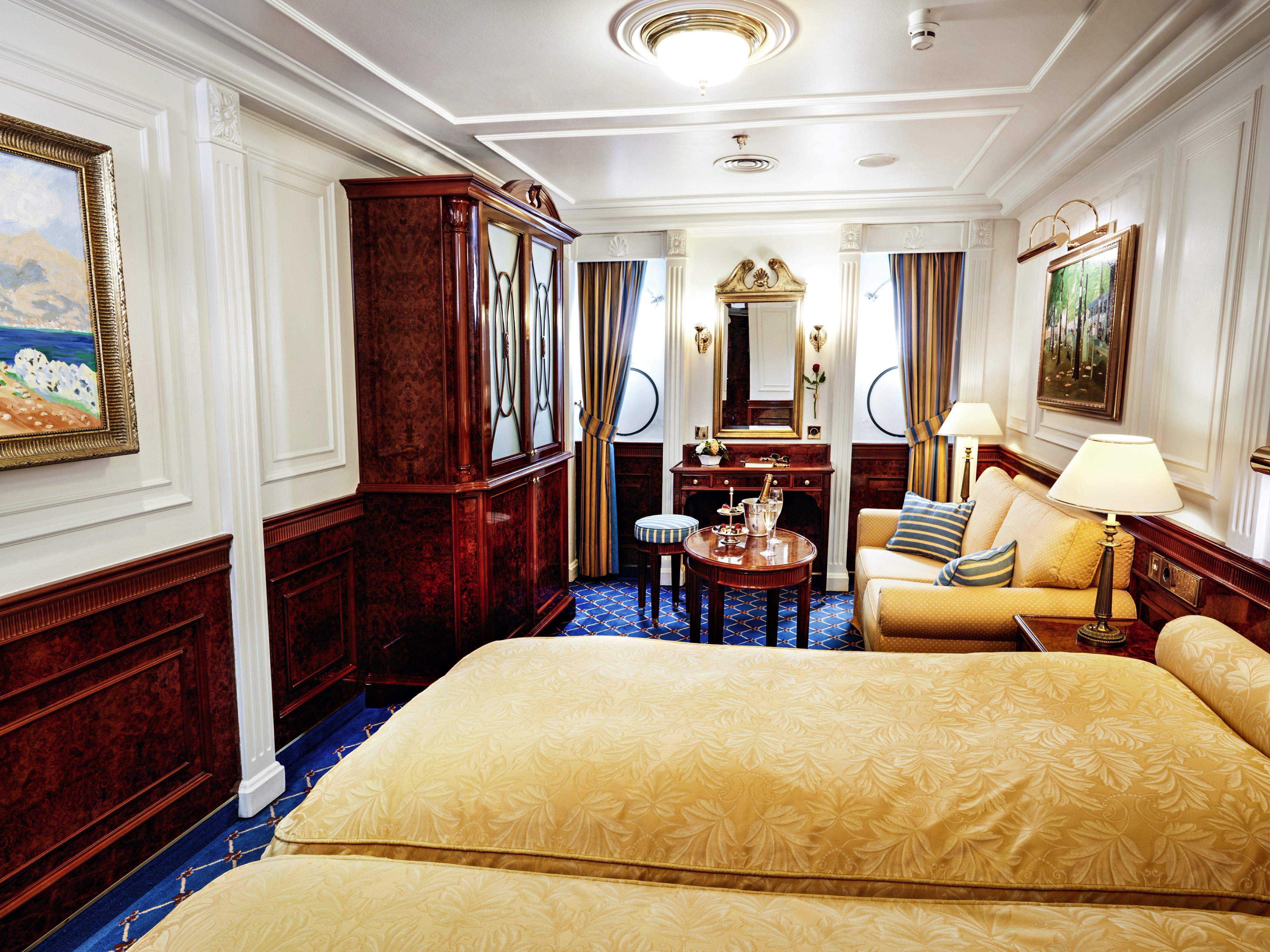
These outside cabins on both sides of the cabin deck are the epitome of cosiness on board the SEA CLOUD II. This is where you can retreat, switch off and relax while enjoying the unique luxurious ambience for which our yachts are famous. Like the other cabins, Category E is equipped with TV/DVD, a mini-bar and a safe. An interesting detail: the double bed can be divided into two single beds on request.

This outside cabin on the cabin deck is still modelled on the officers’ cabins as on traditional windjammers and is equipped with an upper and lower berth. Warm woods and a comfortable sitting area radiate a cosy, maritime atmosphere and offer you a cosy retreat. Our recommendation: this cabin is ideal for single travellers.

Guaranteed double cabins: The range of accommodation starts from Cat. F. You will receive your exact cabin number when arriving on board. The allotment for this category is very limited.
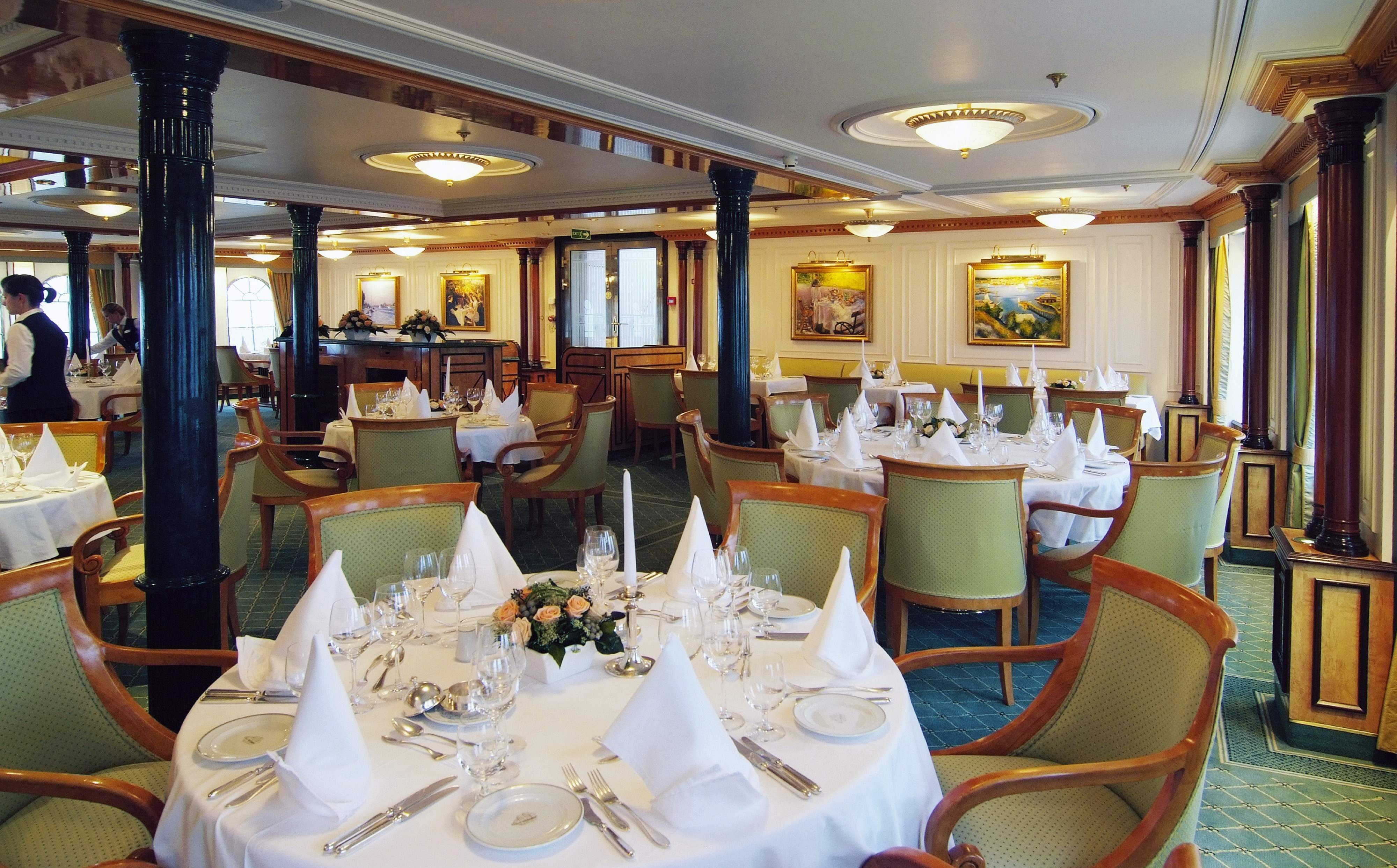
In the restaurant you will find tables for couples and groups of four, six and eight. The lido deck is often an inviting place to have lunch or an evening barbecue out in the open air. No matter whether you are sitting inside or outside, you can all enjoy this feast for the senses together in the same sitting. And since you are dining on a tall ship with the character of a private yacht, you are free to choose your place and company at the table. Our culinary creations are sure to impress even the most discerning of connoisseurs – it is easy to see why the SEA CLOUD II was chosen to join the exclusive Chaîne des Rôtisseurs group.

You will find a dining area and Lido Bar on the Lido Deck.
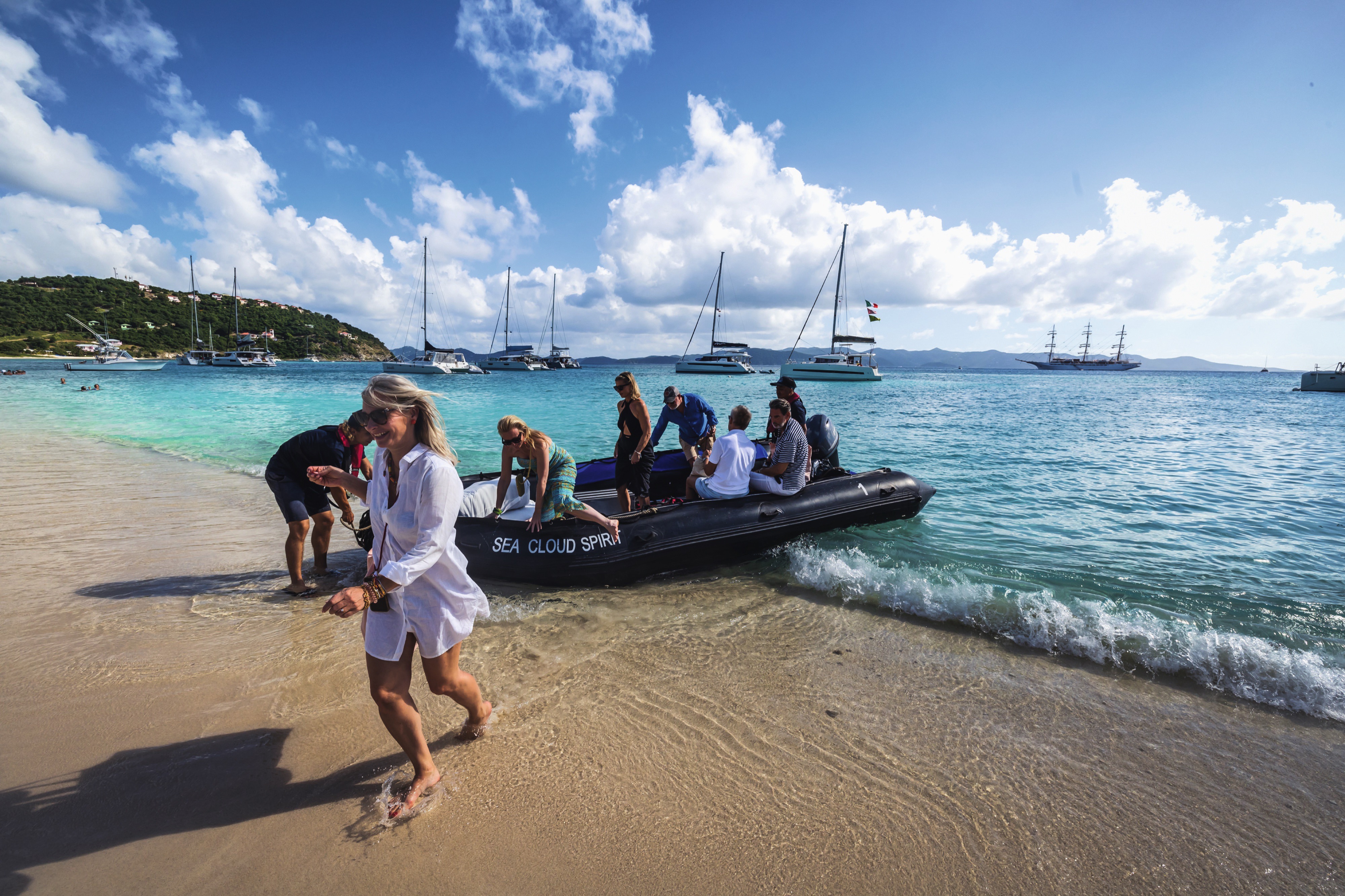
Smaller ships, greater possibilities
Among the many joys of travelling smaller: a quick spin on a zodiac, enjoying the beach barbeques in secluded bays, photo safaris, pausing for a dip in the azure sea. And on selected tours, some exclusive experiences are included – a private concert, an opera house or a palace tour, a culinary visit to a special vineyard, or a front-row seat at a legendary regatta.
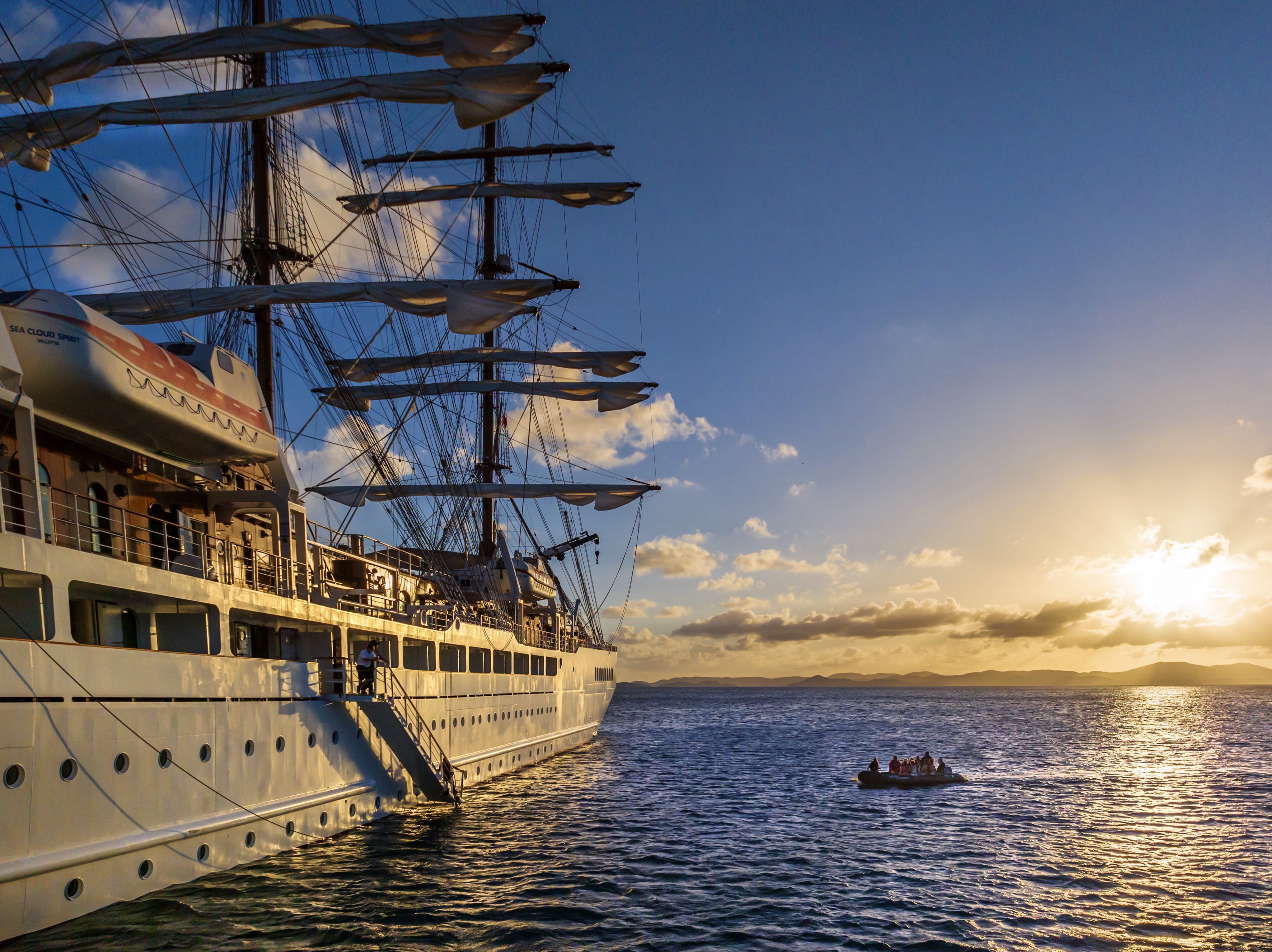
Dive in and be active
Whether you want to start your swim directly from the ship or explore the colorful world on the reef – water sports are even more fun under the Caribbean sun. Equipment is available for everyone: Snorkels, fins and stand-up paddles are waiting for you. If you are in the mood for even greater action, let yourself be glided across the crystal clear waters by tubing in the Caribbean.

In the middle of the lido deck you will find the spacious lounge. At certain times you will hear gentle music from the Steinway piano and, on selected cruises, you can listen to some interesting talks.

Also on the Lido Deck, you will find the library on the lido deck which contains selected literature, DVDs, popular board games, the SEA CLOUD II’s intriguing guest book and a laptop with internet access. But this is not just a place to get engrossed in reading; you should also enjoy the breathtaking all-round view of the ship’s forecastle – do not forget that you are on board a majestic tall ship!
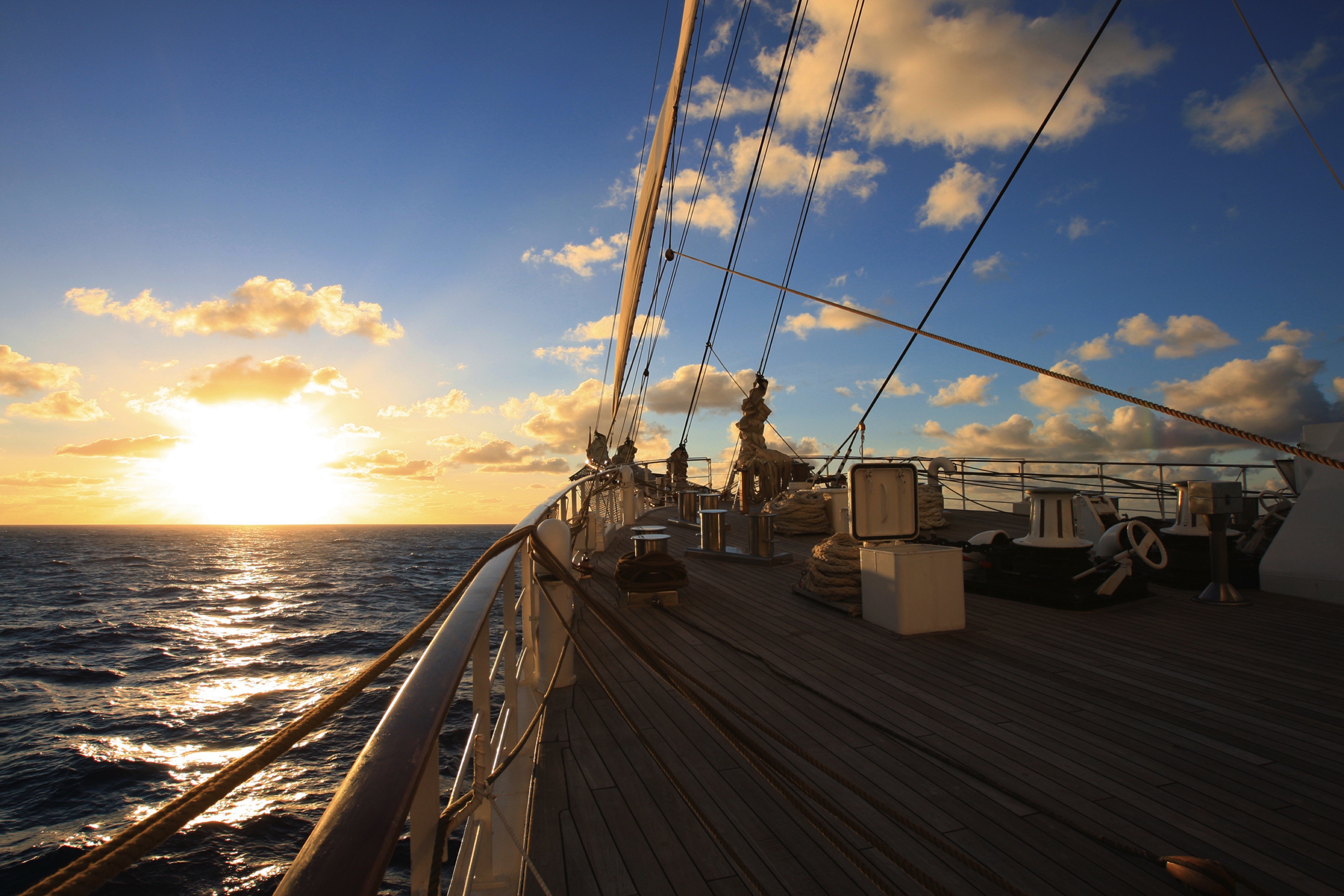
To watch the movement of the sails and all the traditional tasks associated with a tall ship is for many people one of the most wonderful experiences on the high seas. On all the decks you will of course find many traditional deckchairs and benches on which you can sit alone or in a small group, gazing out to sea. On the sun deck you will also find two large sun loungers and the bridge. The officers will be happy to welcome you into the command centre – manoeuvres permitting.
Our snorkelling equipment can be taken ashore at any time. The on-board zodiac boats do not only take you ashore and back to the SEA CLOUD II, but are also used to tow the “Fun Island”, our inflatable water sled for those who fancy some high-speed fun! Depending on sea conditions, the swim platform provides direct access to the largest swimming pool in the world: the sea. And in the evening, the lido deck is a wonderful place to wind down with a nice drink. You might also be entertained by our Crew Shanty Choir.
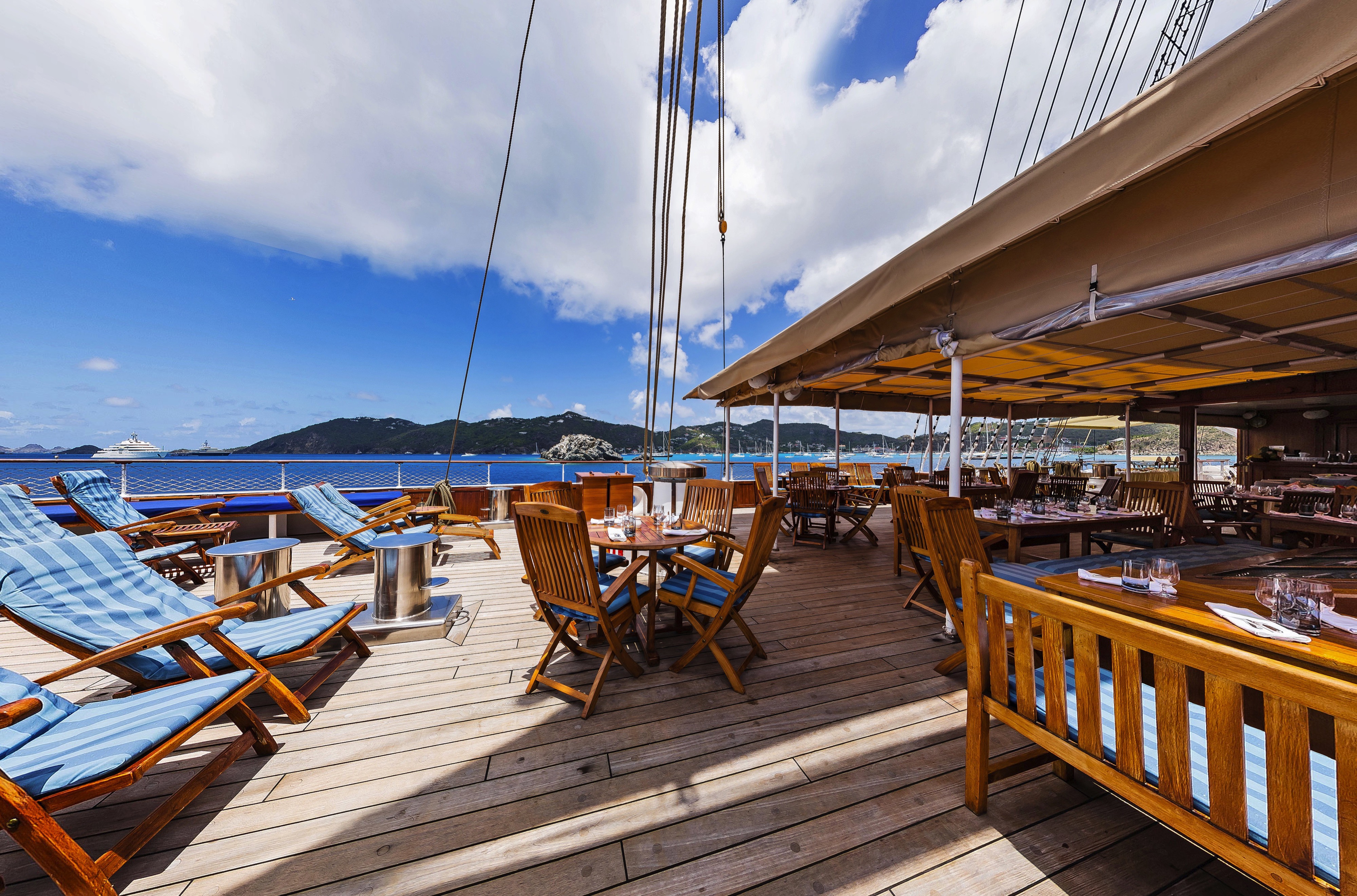
The Lido bar is open daily from 11:00 am. Soft drinks, coffee, tea, water and juices are available all day free of charge.
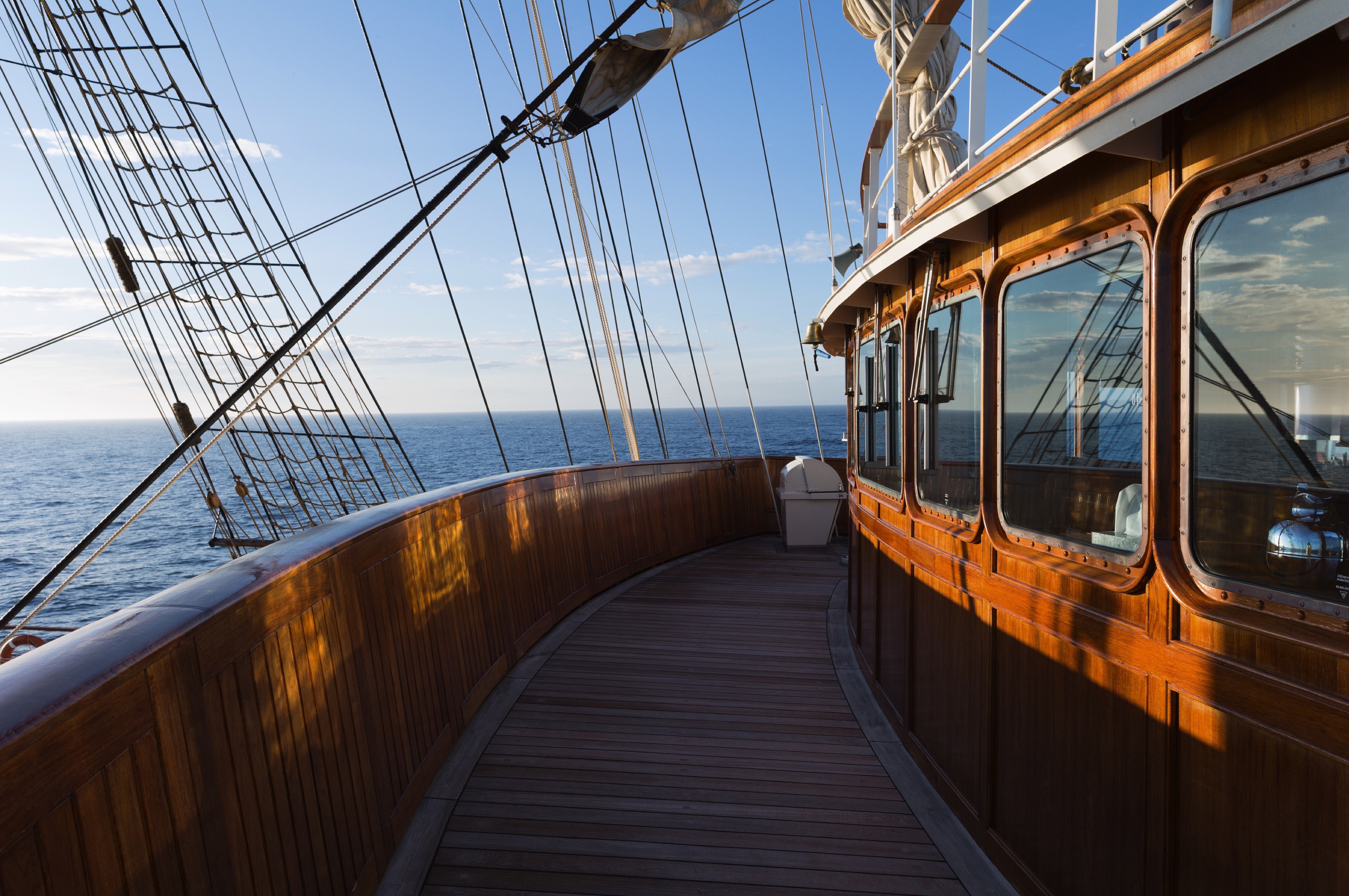
The Bridge can be located on the Sun Deck.
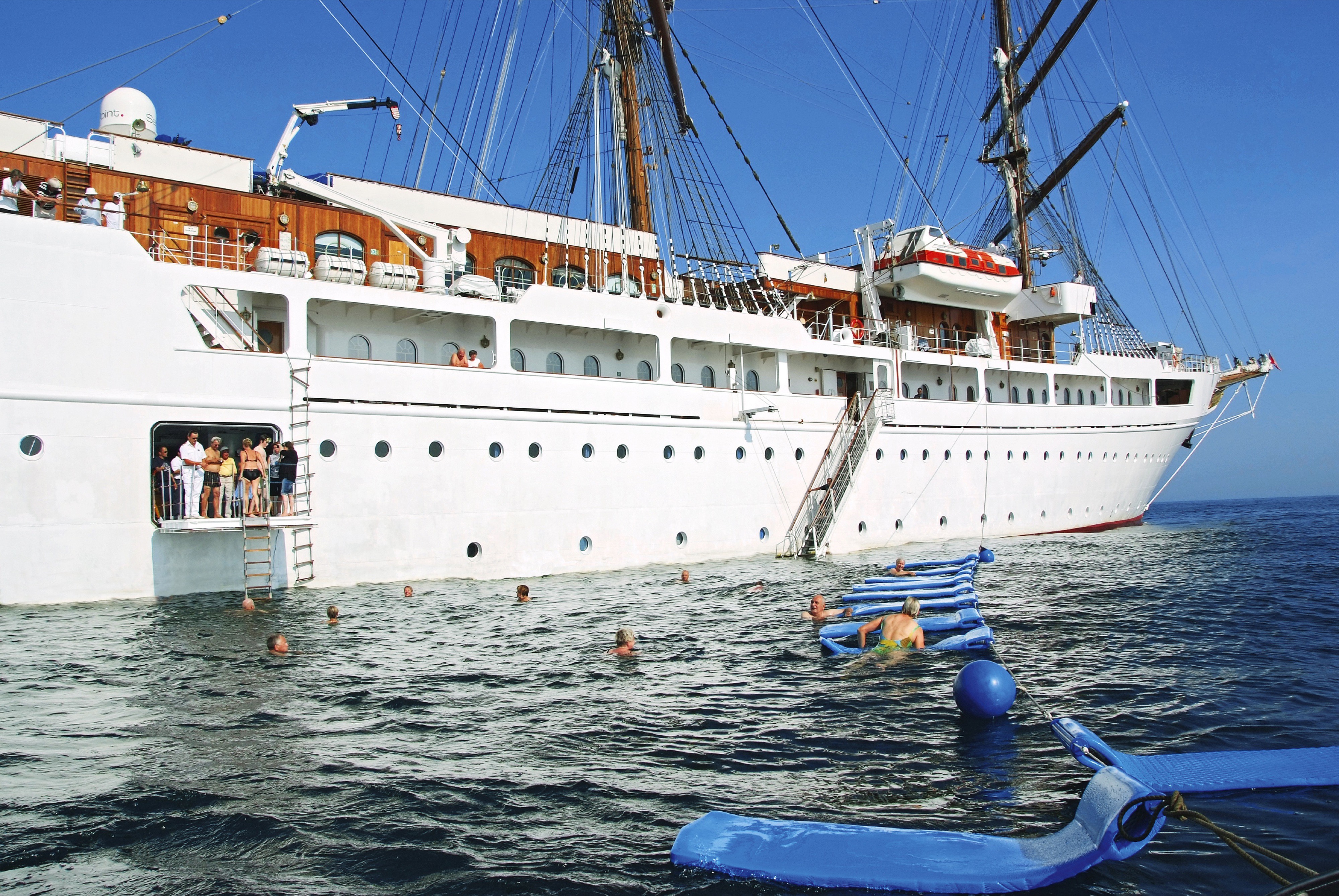
The Swim Platform is located on the cabin deck.
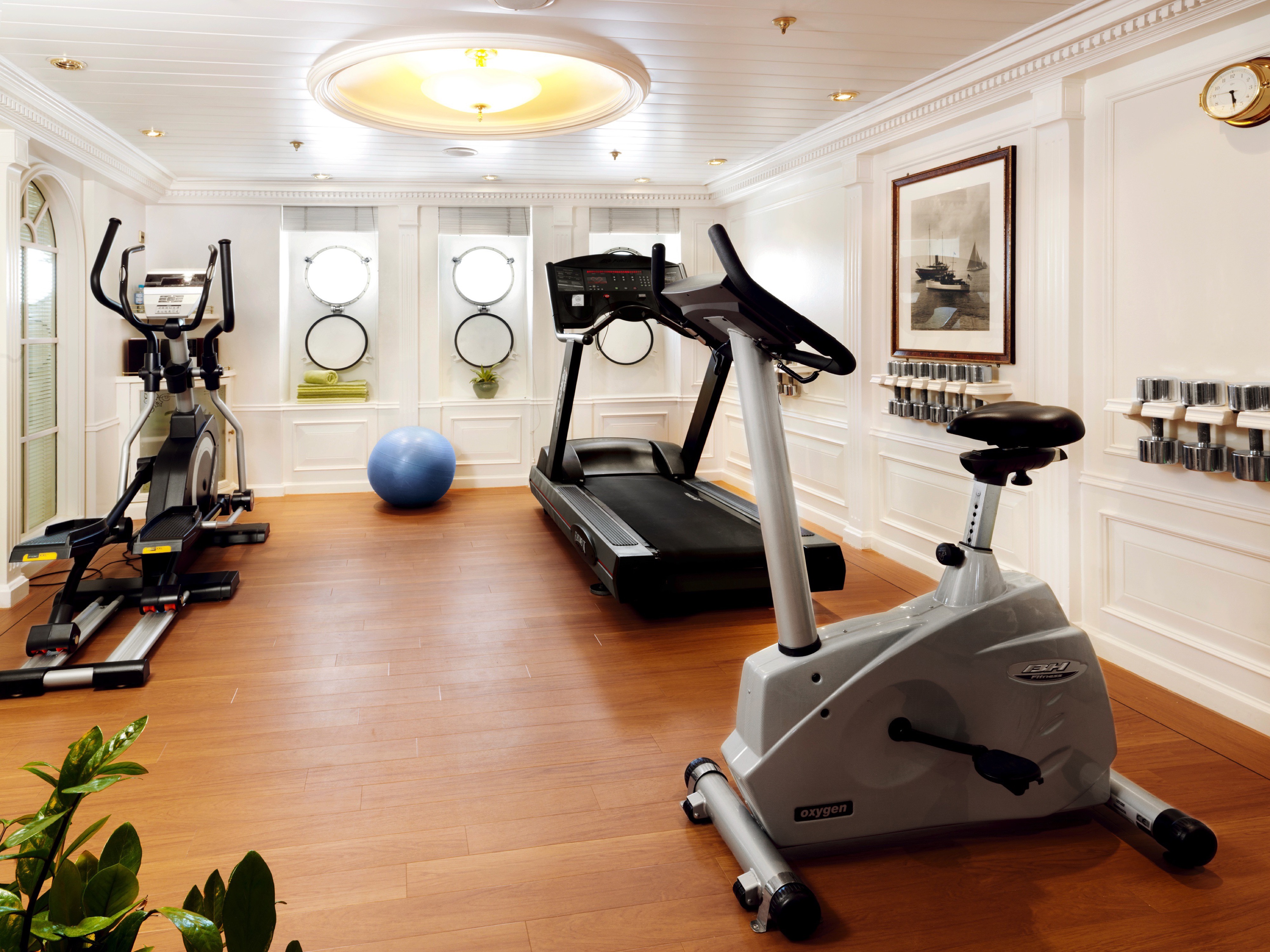
Fitness enthusiasts can use the 100-metre long lido deck as their running/walking circuit while taking in all the different views which you can expect on board a tall ship. For others, our morning exercise sessions are just the way to start a new day. In the smart fitness studio, you will find dumbbells, bikes, treadmills and step machines for more focused workouts, and the adjoining sauna area will enhance your general well-being.

We provide a range of spa services on board the SEA CLOUD II (massages and beauty treatments at additional cost), using the finest products from Maria Galland.
The chef will happily accommodate special diet requests—please let us know about any requests in advance so that we may prepare.
During the day, and depending on the weather, a sophisticated summer look is suitable. For the evening, we recommend smart-casual wear. We also kindly request that guests refrain from wearing shorts at evening meals. The Captain’s Dinner (an event which normally takes place twice on each trip – once on short cruises) is a time when our guests tend to opt for a more elegant look. We recommend a suit for men and appropriate smart dress for women. Please remember to take some non-slip shoes with you.
Our tall ships SEA CLOUD and SEA CLOUD II are not accessible for all people with disabilities and are not suitable for wheelchair users. Please contact our cruise consultancy for further details.
Smoking is permitted only on the outer decks outside of meal times. We kindly request that smokers take the comfort of other passengers into consideration. Smoking is prohibited on the blue lagoon deck and covered areas of the spanker and lido deck at all times.
A laptop is available for use on board in the lounge (SEA CLOUD) or in the library (SEA CLOUD II). You can use this laptop or your own laptop to connect to the internet (Wi-Fi) using the access code, however please note that there is a charge for this. The code can be obtained from reception or the purser.
Laundry services available on board are limited to washing and ironing. There is no dry-cleaning available. The washing and ironing service is provided at an additional charge and is carried out overnight. For guests with bookings in Cat. A-C (SEA CLOUD) or Cat. A+B (SEA CLOUD II), this service is free of charge. For safety reasons, passengers are not permitted to iron in their cabins.
Children are of course very welcome on our ships, however there is no supervision or entertainment available for children.
We approach the people and their cultures with respect in all the regions we visit, travelling mindfully through the local environment. By doing this, we can bring our guests closer – in the truest sense of the word – to these places, and what makes each one special.
THE WINDJAMMER EXPERIENCE
For you and us alike, the key attraction of our trips is the chance to sail on the open seas.
We therefore take every opportunity to set sail and be propelled by the sheer power of the wind. That is why the captain will sometimes change the route if the weather requires it. On board our SEA CLOUD tall ships, you’ll experience the elements, as many of the day-to-day activities take place outside.
HAVING AS LITTLE IMPACT AS POSSIBLE
When we do have to start the engines, we utilise low-sulphur marine diesel on all three of our windjammers.
For us, this is standard practice. Even the SEA CLOUD, our very first windjammer, was equipped with this technology right from the start. Our motto: to minimise our impact on the environment yet still make a profound and positive impression on those around us.
A SUSTAINABLE APPROACH TO LIFE ON-BOARD
Avoiding plastic, reducing water usage and protecting the environment.
These are the factors that guide us in the day to day operation of our ships and our ongoing development of eco-friendly alternatives. To cite just one example, our reusable drinks bottles are not only easy on the eye, but also easy on the environment.
QUALITY, NOT QUANTITY
Our ‘small but perfectly formed’ windjammers are able to visit smaller ports, away from the busy routes frequented by large cruise liners.
With a maximum of 64 to 136 passengers, we’re always welcomed in those locations thanks to our approach of visiting local communities rather than overwhelming them. Needless to say, our itineraries also include some classic destinations, though we usually visit these only when the mega-liners have moved on.
BOOSTING THE LOCAL ECONOMY
Procuring supplies locally, working with local, smaller-scale agencies and paying fair prices.
By taking this approach, we see ourselves as a partner for our local service providers, with whom we’ve built relationships based on trust over many years. After all, we want our voyages to benefit both our guests and the communities we visit around the world.
AUTHENTIC CUISINE
Our menus are always a true reflection of the regional cuisine.
This is because our chefs enjoy buying exotic spices, local specialities and freshly caught fish from local markets to bring you – even in a culinary sense – closer to the places we visit.
A MEMBER OF THE FUTOURIS NETWORK
Heading into the future with Futouris.
Preserving the natural and cultural heritage of our world and shaping the future of tourism in a sustainable way is what Futouris stands for. Members of the network are working globally to improve people’s living conditions, preserve biodiversity and protect the environment and climate.
All three ships have a hospital, which is supervised by a ship’s doctor. Medical consultation hours can be found in the daily program. In case of an emergency, the doctor can be reached at any time by calling 911.
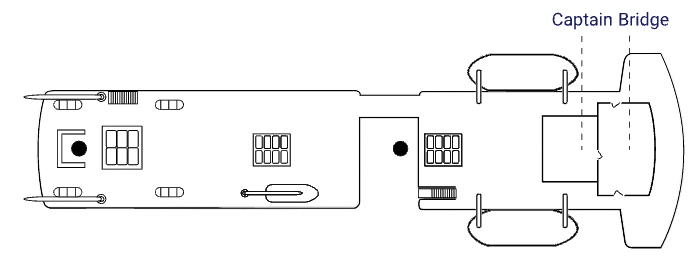
- Captain
- Bridge

- Lounge
- Lido Bar
- Lido Deck
- Library
- Luxury Owner Suites

- Restaurant
- Boutique
- Purser
- Reception
- Junior Suites
- De luxe double-bed cabins

- Fitness Area
- Massage and Cosmetics
- Hospital
- Swim Platform
- De luxe double-bed cabins
- Upper/Lower-bed Cabins

